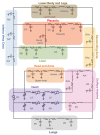Recasting Current Knowledge of Human Fetal Circulation: The Importance of Computational Models
- PMID: 37367405
- PMCID: PMC10299027
- DOI: 10.3390/jcdd10060240
Recasting Current Knowledge of Human Fetal Circulation: The Importance of Computational Models
Abstract
Computational hemodynamic simulations are becoming increasingly important for cardiovascular research and clinical practice, yet incorporating numerical simulations of human fetal circulation is relatively underutilized and underdeveloped. The fetus possesses unique vascular shunts to appropriately distribute oxygen and nutrients acquired from the placenta, adding complexity and adaptability to blood flow patterns within the fetal vascular network. Perturbations to fetal circulation compromise fetal growth and trigger the abnormal cardiovascular remodeling that underlies congenital heart defects. Computational modeling can be used to elucidate complex blood flow patterns in the fetal circulatory system for normal versus abnormal development. We present an overview of fetal cardiovascular physiology and its evolution from being investigated with invasive experiments and primitive imaging techniques to advanced imaging (4D MRI and ultrasound) and computational modeling. We introduce the theoretical backgrounds of both lumped-parameter networks and three-dimensional computational fluid dynamic simulations of the cardiovascular system. We subsequently summarize existing modeling studies of human fetal circulation along with their limitations and challenges. Finally, we highlight opportunities for improved fetal circulation models.
Keywords: cardiovascular lumped-parameter networks; computational fluid dynamics; congenital heart defects; fetal circulation; growth restriction; hemodynamics; patient-specific modeling; pediatric cardiology.
Conflict of interest statement
The authors declare no conflict of interest.
Figures








Similar articles
-
Right ventricle in hypoplastic left heart syndrome exhibits altered hemodynamics in the human fetus.J Biomech. 2020 Nov 9;112:110035. doi: 10.1016/j.jbiomech.2020.110035. Epub 2020 Sep 6. J Biomech. 2020. PMID: 32971490
-
Energetics of Blood Flow in Cardiovascular Disease: Concept and Clinical Implications of Adverse Energetics in Patients With a Fontan Circulation.Circulation. 2018 May 29;137(22):2393-2407. doi: 10.1161/CIRCULATIONAHA.117.033359. Circulation. 2018. PMID: 29844073 Review.
-
The transition from fetal to neonatal circulation: normal responses and implications for infants with heart disease.Semin Perinatol. 1993 Apr;17(2):106-21. Semin Perinatol. 1993. PMID: 8327901 Review.
-
Understanding Fetal Hemodynamics Using Cardiovascular Magnetic Resonance Imaging.Fetal Diagn Ther. 2020;47(5):354-362. doi: 10.1159/000505091. Epub 2020 Feb 14. Fetal Diagn Ther. 2020. PMID: 32062652 Review.
-
Fetal hemodynamics and cardiac streaming assessed by 4D flow cardiovascular magnetic resonance in fetal sheep.J Cardiovasc Magn Reson. 2019 Jan 21;21(1):8. doi: 10.1186/s12968-018-0512-5. J Cardiovasc Magn Reson. 2019. PMID: 30661506 Free PMC article.
Cited by
-
Exploring the prospects, advancements, and challenges of in vitro modeling of the heart-brain axis.Front Cell Neurosci. 2024 May 3;18:1386355. doi: 10.3389/fncel.2024.1386355. eCollection 2024. Front Cell Neurosci. 2024. PMID: 38766369 Free PMC article.
-
An in silico analysis of heart rate impact on wall shear stress hemodynamic parameters in aortic coarctation.Sci Rep. 2025 Jan 22;15(1):2747. doi: 10.1038/s41598-025-85522-0. Sci Rep. 2025. PMID: 39837894 Free PMC article.
References
Publication types
Grants and funding
LinkOut - more resources
Full Text Sources

